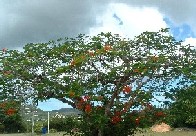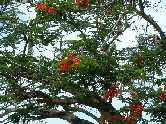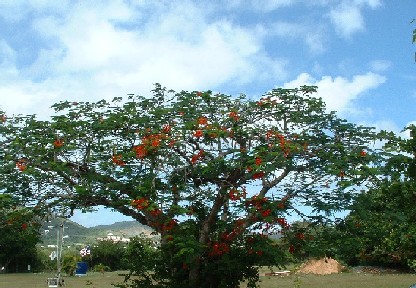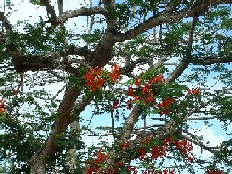This tree is called the FLAMBOYANT TREE.


In Hawaii, this flower is called "ohai 'ula." The tree has a reddish color. This tree bares in the winter time. It blooms during the early spring and ends in the late summer.
Each of the flowers have five petals. One flower is white and another one is yellow. This tree is a member of the Legume family. It is one of the most beautiful trees in the world.
The Flamboyant tree is also called the "Delonix regia."
The tree is known by several different names such as- the Royal Poinciana, peacock flower, gulmohar fabaceae, and the flame tree. This is a flowering tropical flowering tree. The flamboyant tree is often found in warm climates. The tree produces purplish-brown seed pods that are more than two feet lomg. The flower has fernlike leaves. It is divided into many leaflets. The branches can grow up to 40 feet high. Poincianas also belong to the pea family. The flamboyant tree is one of the most colorful trees in the world.
It is widely planted throughout the tropics. The flamboyant tree is also grown in southern California. The flamboyant tree is deciduous in the winter time. This tree grows very fast in the sun. It requires moderate water. The flamboyant tree is also known as the Mohur tree.
Information on trees
A tree is the largest of all plants. Many trees usually live longer than other plants. Trees are the oldest living things. Most trees grow at least 15 to 20 feet. Trees can be divided into two groups: coniferous and broad-leaved. Conifers produce cones and have needles. Broad-leaved trees are generally decidious in that they shed their wide flat leaves in the autumn. Trees are nourished by their leaves. Trees with needles are often identified as pines.
Trees have one woody stem which is called the trunk. The stem grows at least three to four inches thick. Shrubs, like trees, have several woody stems. Most shrubs have more than one stem. Trees help conserve soil and water. In open country, trees act as windbreaks and keeps the wind from blowing away top soil. Their roots prevent soil from being washed away by heavy rains. Tree roots also help store water in the ground. In mountain regions, forests prevent sliding snow from causing avalanches. Forests also provide shelter for wildlife and recreation areas for vacationists. Trees help preserve the balance of gases in the atmosphere. A tree's leaves absorb carbon dioxide from the air. They also produce oxygen and release it into the atmosphere.
There are about 20,000 kinds of trees. More than 1,000 kinds grow in the United States. They range from mighty forest trees to fragile ornamentals. The greatest variety of trees grow in wet tropical regions. Broadleaf trees are the most varied. Broadleaf trees are the most numerous and varied of the world's trees. They include ashes, elms, maples, oaks, walnuts, willows, and many other familiar trees of the United States. They also include most trees of the tropics, such as mahogany trees and mangrove trees.
Needleleaf trees include such familiar trees as firs, hemlocks, pines, redwoods, and spruces. There are about 500 species of needleleaf trees. Most of them have narrow, pointed, needlelike leaves. But a few types, such as cedars and junipers, have narrow, scalelike leaves. Most needleleaf trees are evergreen, though they produce new needles each year. The oldest needles turn yellow or brown and drop, but the youngest needles remain green and do not fall. A few species of needleleaf trees are deciduous.
A tree has three main parts: the trunk and branches, the leaves, and the roots. The branches and leaves together are called the crown. The trunk supports the crown and holds it up to the sunlight. Tree ferns, cycads, and most palms have no branches. Their crowns consist only of leaves. The roots of most trees are hidden in the ground, but they may take up as much space as the trunk and crown do above the ground.
Trunk and branches give a tree its shape. The trunks of most needleleaf trees grow straight up to the top of the tree. The branches grow out from the trunk. On most needleleaf trees, the branches near the top are shorter than those farther down, which gives the crown a spirelike shape. The trunks of most broadleaf trees do not reach to the top of the tree. Instead, the trunk divides into spreading branches near the base of the crown, giving the crown a rounded shape.
Most broadleaf trees grow best in regions that are warm and moist at least three or four months of the year. Colder, dryer climates are better suited to most needleleaf trees. Different kinds of trees also require different soils. Many needleleaf trees grow well in poor, sandy soil. But most broadleaf trees need more fertile soil. Some trees grow alone or in small groups. Where moisture is scarce, trees may grow only along riverbanks. tree. A tree should be planted where it will have enough room when fully grown. The soil should be fertile and should drain well so that water does not collect and drown the roots.
Here are more pictures of the Flamboyant tree.




Visit this site.

|
Click here to  visit this site |
Bibliography
"Royal Poinciana." Encarta Reference Library. Microsoft Corporation: Encyclopedia, Copyright 1993-2002.
The Plant Database Website (http://plantsdatabase.com).
Tropical Blossoms of the Caribbean/ Author: Dorothy and Bob Hargreaves/Publisher: By Hargreaves Company, Inc./ Copyright: 1958.
Tropical Trees of Hawaii/ Author: Dorothy and Bob Hargreaves/ Publisher: By Hargreaves Company, Inc/ Copyright: 1964.